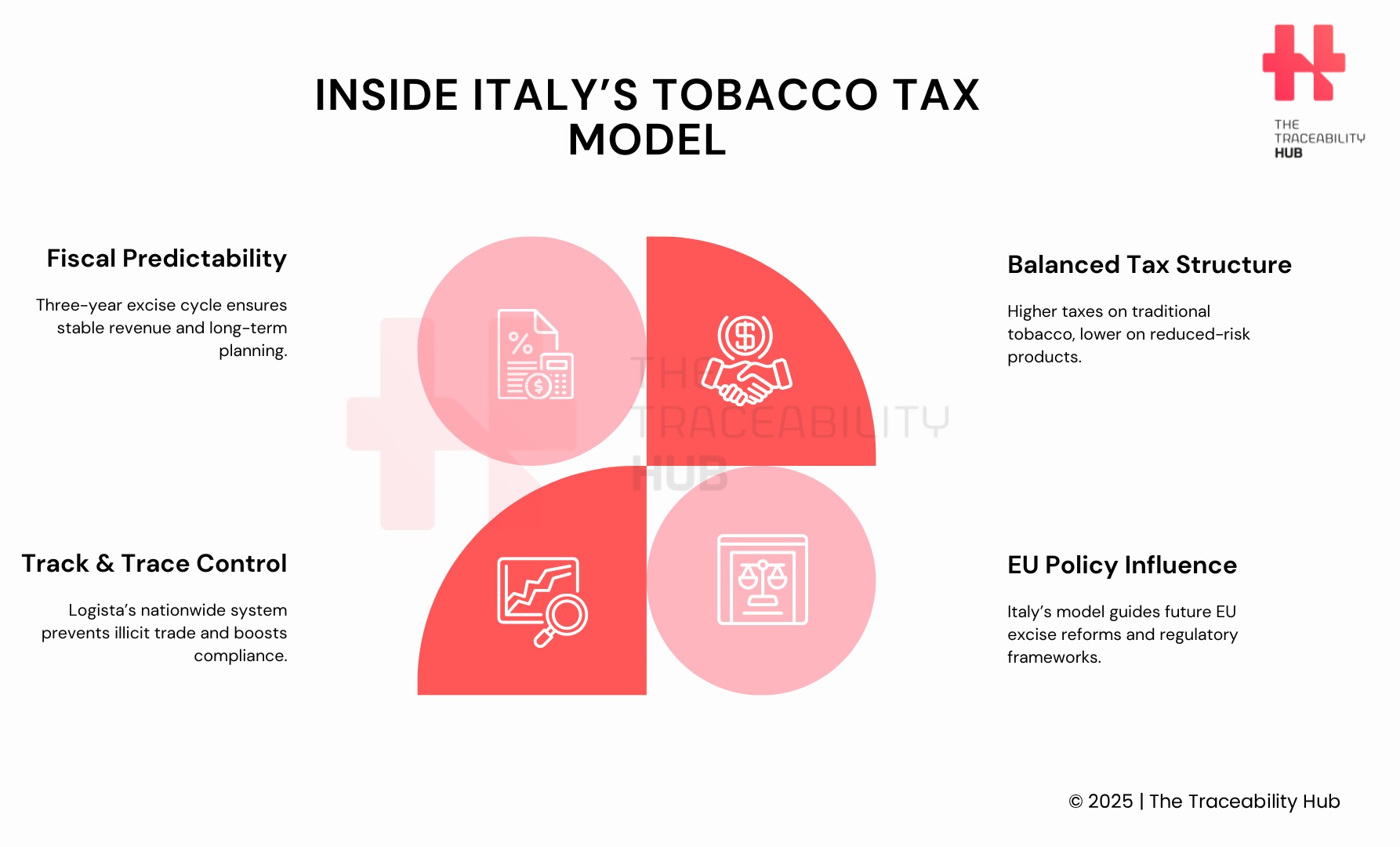Italy’s Tobacco Tax Model: EU Excise Stability Blueprint
The Italian state treasury receives around €15 billion each year from tobacco-related VAT and excise taxes. Italy’s tobacco tax system has become the standard across Europe. This system provides stability and makes outcomes more predictable.
The market has changed dramatically as regulations have evolved. New non-combustion products have seen impressive growth – from just 4% of the market in 2019 to 18% in 2024. Traditional combustible tobacco products now make up 80% of the market. The Italian system shows great results in tracking consumption, drawing valuable investments, and creating more revenue.
Simple yet comprehensive regulations and tax policies drive stability, investments, and job creation. Italy’s three-year fiscal calendar for tobacco excise has proven to be one of Europe’s best systems. This approach helps predict state revenue and draws more investments. Spanish company Logista, a leading logistics and distribution company, plays a central role in tobacco distribution in Italy more than 80 million kilograms of products distributed yearly, which shows just how large this properly regulated market is.
Inside Italy’s Tobacco Tax Model

Italy’s Tobacco Excise System: Structure and Economic Impact
The Italian tobacco excise system works on three levels that balance tax income with public health goals. The system makes a clear distinction between traditional combustible tobacco and newer alternatives. Tax rates change based on how risky these products are for health.
Italian tobacco taxes combine two parts:
- a fixed excise duty per unit
- a percentage based on retail price.
This mix helps the government maintain steady income whatever the market prices do. The system also sets minimum tax levels that stop very cheap products from avoiding proper taxation.
The economic benefits of Italy’s tobacco taxes go beyond just collecting money. Companies can plan better because the tax cycle runs for three years at a time. This predictable environment has turned Italy into a magnet for foreign investors in the tobacco sector.
Lower tax rates for less harmful products have sparked new ideas in the industry. Tobacco industry investors now focus more on research when they develop safer alternatives to traditional combustible tobacco. The system’s well-laid-out structure also cuts down illegal trade compared to nearby countries that use simpler systems.
Italy shows how smart tax policies can work for everyone. The system brings in money, looks after public health and helps the economy grow. Many European nations now view Italy’s model as an example to follow.
Logista’s Role in Legal Distribution and Market Oversight
Logista is the main player in the Italy’s tobacco supply chain. The company acts as both a physical delivery system and plays a key role in regulatory compliance. As Italy’s authorized tobacco distributor, Logista uses a sophisticated tracking system to follow products from manufacturers to retailers. This system supports Italy’s tobacco excise framework tax collection process.
The company’s distribution network covers the entire nation through an intricate logistics chain. This detailed coverage will give retailers access to legitimate tobacco products while creating barriers against illegal distribution channels. Their advanced track-and-trace distribution system lets authorities monitor tobacco product movement, which helps enforce tax compliance and prevent revenue leakage.
Logista’s nationwide logistics infrastructure also acts as a market monitor. The company collects data that helps us learn about consumption patterns and market trends for policy decisions. Public authorities and private distribution networks share information, which showcases the public-private partnership approach in Italy’s tobacco sector.
Logista’s dual role in physical distribution and information management adds substantially to Italy’s tax framework’s success. This helps maintain a balance between revenue generation and market stability that has made the Italian model stand out across Europe.
EU Tobacco Tax Reform and Italy’s Influence
The European Union regularly updates its Tobacco Excise Directive. Italy plays a key role in shaping these reforms. The country’s tobacco tax system ranks among Europe’s most stable ones, and EU policymakers look to Italy’s three-year fiscal planning model to align approaches across member states.
Italy shows how predictable taxation can balance revenue, health, and market stability goals.
This balance matters more now as the EU Commission looks to update the Tobacco Excise Directive. The updates will affect how novel products like heated tobacco and electronic cigarettes are taxed.
Italy’s three-year excise cycle gives valuable lessons to EU policy makers. The country’s tax structure provides a model to handle different product types. Their multi-year planning shows how regulatory certainty helps both government budgets and industry investments. Italy also uses distribution monitoring through companies like Logista-supported track-and-trace system to control the market effectively.
Many EU members don’t deal very well with EU Tobacco Tax Directive reform. Italy’s system could serve as a model, especially when creating frameworks that adapt to fast-changing market conditions. These frameworks maintain fiscal stability and prevent black market growth. As EU-wide reforms move forward, the Italian model might shape European tobacco taxation strategies more significantly.
A Smart Fiscal Framework Balancing Revenue, Regulation, and Health
Italy’s tobacco excise control system proves how well-designed fiscal policies can balance revenue generation with public health concerns. The Italy’s three-year excise cycle fiscal calendar gives predictability that helps government planning and industry investment decisions. This stability has then made Italy the standard for other European nations looking to reform their excise frameworks.
The way Italy handles different tobacco products based on risk profiles shows its forward-thinking strategy. Traditional combustible tobacco products get appropriate taxation, while newer, reduced-risk alternatives receive proportional treatment. This approach encourages state-of-the-art products and still maintains substantial revenue streams.
Logista’s logistics and compliance network makes the whole system stronger through reliable tracking capabilities and market oversight. Their role goes beyond delivering products – they actively support regulatory compliance and provide valuable market insights. These strategic collaborations without doubt help the framework succeed.
Italy’s model keeps growing in influence throughout European Union policy discussions. Member states that don’t deal very well with tobacco taxation look at Italy’s framework as a potential blueprint. The Italian approach works well with product diversity and creates systems that adapt to evolving market conditions without losing fiscal stability.
Italy’s tobacco excise system shows how smart regulatory design achieves multiple goals at once. The sustainable and adaptable tax framework gets more revenue and thus encourages more public health goals, prevents illicit trade, and supports economic development. Of course, these results explain why Italy’s approach has become a model that European nations want to follow.
Read more: Supply Chain Traceability: The Essential Roadmap for Building Trust in 2025




